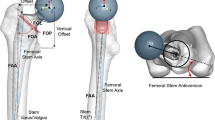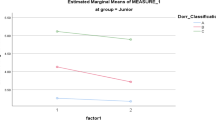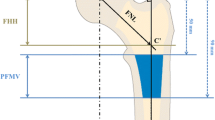Abstract
Objective: To observe the accuracy of femoral preparation and the position of the cementless prosthesis in femoral cavity, and to compare the results between the computer-assisted surgical group (CASPAR) and the conventional group. Methods: Ten femoral components were implanted either manually or by CASPAR in cadaver femurs. The specimens were cut to 3 mm thick slices. Microradiograms of every slice were sent to a computer for analysis with special software (IDL). The gaps and the medullary cavities between component and bone, the direct bone contact area of the implant surface, the gap width and the percentage of gap and bone contact area were measured in every slice. Results: In the proximal implant coated with HA of the CASPAR group, the average percentage of bone contact reached 93.2% (ranging from 87.6% to 99.7%); the average gap percentage was 2.9% (ranging from 0.3% to 7.8%); the maximum gap width was 0.81 mm and the average gap width was only 0.20 mm. While in the conventional group, the average percentage of bone contact reached 60.1% (ranging from 49.2% to 70.4%); the average gap percentage was 32.8% (ranging from 25.1% to 39.9%); the maximum gap width was 2.97 mm and the average gap width was 0.77 mm. The average gap around the implant in the CASPAR group was only 9% of that in the manual group; the maximum and average gap widths were only about 26% of those in the manual group. On the other hand, the CASPAR group showed 33% higher bone contact than the manual group. Conclusion: With the use of robotics-assisted system, significant progress can be achieved for femoral preparation in total hip arthroplasty.
Similar content being viewed by others
References
Amstutz, H.C., Kabo, J.H., King, R.C., 1991. Press-fit prosthesis: Principle, Results, and Techniques. In: Amstutz, H.C. (Ed.), Hip Arthroplasty. 1st ed. Churchill Livingstone, New York, p. 261–270.
Bargar, W.L., 1989. Shape the implant to the patient. A rationale for the use of custom-fit cementless total hip implants. Clin Orthop, 249: 73–78.
Bargar, W.L., Bauer, A., Borner, M., 1998. Primary and revision total hip replacement using the Robodoc system. Clin Orthop, 354: 82–91.
Barrack, R.L., Jasty, M., Bragdon, C., Haire, T., Harris, W.H., 1992. Thigh pain despite bone ingrowth into uncemented femoral stems. J Bone Joint Surg [Br], 74: 507–510.
Bobyn, J.D., Pilliar, R.M., Cameron, H.U., Weatherly, G.C., 1981. Osteogenic phenomena across endosteal bone-implant spaces with porous surfaced intramedullary implants. Acta Orthop Scand, 52: 145–153.
Capello, W.N., Sallay, P.I., Feinberg, J.R., 1994. Omniflex modular femoral component. Two-to five-year results. Clin Orthop, 298: 54–59.
Carlsson, L., Rostlund, T., Albrektsson, B., Albrektsson, T., 1988. Implant fixation improved by close fit. Cylindrical implant-bone interface studied in rabbits. Acta orthop Scand, 59: 272–275.
Collier, J.P., Mayor, M.B., Chae, J.C., Surprenant, V.A., Surprenant, H.P., Dauphinais, L.A., 1988. Macroscopic and microscopic evidence of prosthetic fixation with porous-coated materials. Clin Orthop, 235: 173–180.
Cook, S.D., Barrack, R.L., Thomas, K.A., Haddad, R.J., 1988. Quantitative analysis of tissue growth into human porous total hip components. J Arthroplasty, 3: 249–262
Dalton, J.E., Cook, S.D., Thomas, K.A., Kay, J.F., 1995. The effect of operative fit and hydroxyapatite coating on the mechanical and biological response to porous implants. J Bone Joint Surg [Am], 77: 97–110.
Dujardin, F.H., Mollard, R., Toupin, J.M., Coblentz, A., Thomine, J.M., 1996. Micromotion, fit, and fill of custom made femoral stems designed with an automated process. Clin Orthop, 325: 276–289.
Engh, C.A., Bobyn, J.D., Glassman, A.H., 1987. Porous-coated hip replacement. The factors governing bone ingrowth, stress shielding, and clinical results. J Bone Joint Surg [Br], 69: 45–55.
Honl, M., Dierk, O., Gauck, C., Carrero, V., Lampe, F., Dries, S., Quante, M., Schwieger, K., Hille, E., Morlock, M.M., 2003. Comparison of robotic-assisted and manual implantation of a primary total hip replacement. A prospective study. J Bone Joint Surg [Am], 85: 1470–1478.
Jasty, M., Bragdon, C.R., Rubash, H., Schutzer, S.F., Haire, T., Harris, W., 1992. Unrecognized femoral fractures during cementless total hip arthroplasty in the dog and their effect on bone ingrowth. J Arthroplasty, 7: 501–508.
Jerosch, J., Peuker, E., von Hasselbach, C., Lahmer, A., Filler, T., Witzel, U., 1999. Computer assisted implantation of the femoral stem in THA—an experimental study. Int Orthop, 23: 224–226.
Kim, Y.H., Kim, V.E., 1992. Results of the Harris-Galante cementless hip prosthesis. J Bone Joint Surg [Br], 74: 83–87.
Kold, S., Mouzin, O., Bourgeault, C., Soballe, K., Bechtold, J.E., 2003. Femoral fracture risk in hip arthroplasty: smooth versus toothed instruments. Clin Orthop, 408: 180–188.
Lind, M., Overgaard, S., Ongpipattanakul, B., Nguyen, T., Bunger, C., Soballe, K., 1996. Transforming growth factor-beta 1 stimulates bone ongrowth to weight-loaded tricalcium phosphate coated implants: an experimental study in dogs. J Bone Joint Surg [Br], 78: 377–382.
Martell, J.M., Pierson, R.H. 3rd, Jacobs, J.J., Rosenberg, A.G., Maley, M., Galante, J.O., 1993. Primary total hip reconstruction with a titanium fiber-coated prosthesis inserted without cement. J Bone Joint Surg [Am], 75: 554–571.
McLaughlin, J.R., Lee, K.R., 2000. Total hip arthroplasty in young patients. 8- to 13-year results using an uncemented stem. Clin Orthop, 373: 153–163.
Mont, M.A., Maar, D.C., Krackow, K.A., Jacobs, M.A., Jones, L.C., Hungerford, D.S., 1993. Total hip replacement without cement for non-inflammatory osteoarthrosis in patients who are less than forty-five years old. J Bone Joint Surg [Am], 75: 740–751.
Noble, P.C., Alexander, J.W., Lindahl, L.J., Yew, D.T., Granberry, W.M., Tullos, H.S., 1988. The anatomic basis of femoral component design. Clin Orthop, 235: 148–165.
Nogler, M., Polikeit, A., Wimmer, C., Bruckner, A., Ferguson, S.J., Krismer, M., 2004. Primary stability of a robodoc implanted anatomical stem versus manual implantation. Clin Biomech (Bristol, Avon), 19: 123–129.
Otani, T., Whiteside, L.A., White, S.E., McCarthy, D.S., 1995. Reaming technique of the femoral diaphysis in cementless total hip arthroplasty. Clin Orthop, 311: 210–221.
Paul, H.A., Bargar, W.L., Mittlestadt, B., Musits, B., Taylor, R.H., Kazanzides, P., Zuhars, J., Williamson, B., Hanson, W., 1992. Development of a surgical robot for cementless total hip arthroplasty. Clin Orthop, 285: 57–66.
Ragab, A.A., Kraay, M.J., Goldberg, V.M., 1999. Clinical and radiographic outcomes of total hip arthroplasty with insertion of an anatomically designed femoral component without cement for the treatment of primary osteoarthritis. A study with a minimum of six years of follow-up. J Bone Joint Surg [Am], 81: 210–218.
Robertson, D.D., Walker, P.S., Hirano, S.K., Zhou, X.M., Granholm, J.W., Poss, R., 1988. Improving the fit of press-fit hip stems. Clin Orthop, 228: 134–140.
Robinson, R.P., Clark, J.E., 1996. Uncemented press-fit total hip arthroplasty using the Identifit custom-molding technique. A prospective minimum 2-year follow-up study. J Arthroplasty, 11: 247–254.
Sandborn, P.M., Cook, S.D., Spires, W.P., Kester, M.A., 1988. Tissue response to porous-coated implants lacking initial bone apposition. J Arthroplasty, 3: 337–346.
Schutzer, S.F., Grady-Benson, J., Jasty, M., O’Connor, D.O., Bragdon, C., Harris, W.H., 1995. Influence of intraoperative femoral fractures and cerclage wiring on bone ingrowth into canine porous-coated femoral components. J Arthroplasty, 10: 823–829.
Thomsen, M.N., Breusch, S.J., Aldinger, P.R., Gortz, W., Lahmer, A., Honl, M., Birke, A., Nagerl, H., 2002. Robotically-milled bone cavities: a comparison with hand-broaching in different types of cementless hip stems. Acta Orthop Scand, 73: 379–385.
Walker, P.S., Culligan, S.G., Hua, J., Muirhead-Allwood, S.K., Bentley, G., 2000. Stability and bone preservation in custom designed revision hip stems. Clin Orthop, 373: 164–173.
Author information
Authors and Affiliations
Corresponding author
Additional information
Project supported by the Klinik für Orthopädie of Kiel University in Germany
Rights and permissions
About this article
Cite this article
Wu, Ld., Hahne, H.J. & Hassenpflug, J. The dimensional accuracy of preparation of femoral cavity in cementless total hip arthroplasty. J. Zheijang Univ.-Sci. 5, 1270–1278 (2004). https://doi.org/10.1631/jzus.2004.1270
Received:
Accepted:
Published:
Issue Date:
DOI: https://doi.org/10.1631/jzus.2004.1270




